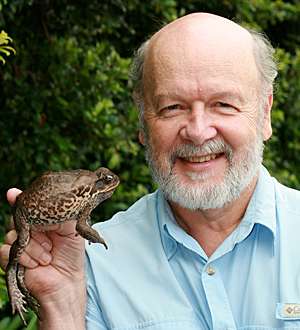July 30, 2013 report
Cane toad pioneers speed up invasions

(Phys.org) —Climate change is one of a number of stressors that cause species to disperse to new locations. Scientists must be able to predict dispersal rates accurately, as the movement of a new species into an area can have a significant, and sometimes detrimental, effect on that area's ecology. When studying dispersal rates of cane toads in Australia, Tom Lindstrom of the University of Sydney and his colleagues found that toads that are first to move into a new area travel at faster rates than toads that arrive later. Their research, published in the Proceedings of the National Academy of Sciences, shows that failure to account for this has caused scientists to severely underestimate dispersal rates.
Australia's Bureau of Sugar Experiment Stations brought cane toads from America to Australia in 1935, in order to control beetles that were infesting sugar cane. Since then, cane toad populations have spread widely, and the toads, which secrete a toxin, disrupt the native ecology. In order to predict how cane toad populations will shift in response to environmental stressors, scientists have been studying movement patterns of established toad populations. Lindstrom and his team contend that by ignoring the differences between "pioneer" toads, who are the first to enter a site, and toads that have been at a site for a few years, previous predictions of dispersal rates have been inaccurate.
The team studied eight years worth of data from radio-tracked toads that had colonized a site in tropical Australia. Using a Bayesian model, the researchers analyzed the data and determined that pioneer toads were more likely move in constant directions and take long steps than toads that arrived a few years later. These toads tended to take short steps and frequently make sharp-angled turns. Because of these behavioral differences, toads at the forefront of an invasion covered almost twice as much ground as later-arriving toads.
The team found physical differences between the pioneer toads and the other toads that could account for the pioneers' faster movements. For example, pioneer toads had longer legs. The researchers speculate that because pioneers can only mate with each other, inherited physical differences between pioneers and other toads increase over time. This causes pioneers to continually become more "athletic" in comparison to the other toads. In fact, many of the cane toad pioneers had spinal arthritis, indicating that they had reached physiological or biomechanical tolerance limits. Lindstrom and his team suggest that environmental conditions may enhance the effects of physical "improvements" in pioneer populations; for example, pioneers may find travel during wet seasons easier than their slower conspecifics.
The researchers claim that many other species have exhibited rapid dispersal rates during the earliest phases of invasions. By restricting data to that obtained from organisms long-established in an area and ignoring variations in environmental conditions, scientists may routinely be underestimating the speeds at which species can invade new territories.
More information: Rapid shifts in dispersal behavior on an expanding range edge, PNAS, Published online before print July 29, 2013, doi: 10.1073/pnas.1303157110
Abstract
Dispersal biology at an invasion front differs from that of populations within the range core, because novel evolutionary and ecological processes come into play in the nonequilibrium conditions at expanding range edges. In a world where species' range limits are changing rapidly, we need to understand how individuals disperse at an invasion front. We analyzed an extensive dataset from radio-tracking invasive cane toads (Rhinella marina) over the first 8 y since they arrived at a site in tropical Australia. Movement patterns of toads in the invasion vanguard differed from those of individuals in the same area postcolonization. Our model discriminated encamped versus dispersive phases within each toad's movements and demonstrated that pioneer toads spent longer periods in dispersive mode and displayed longer, more directed movements while they were in dispersive mode. These analyses predict that overall displacement per year is more than twice as far for toads at the invasion front compared with those tracked a few years later at the same site. Studies on established populations (or even those a few years postestablishment) thus may massively underestimate dispersal rates at the leading edge of an expanding population. This, in turn, will cause us to underpredict the rates at which invasive organisms move into new territory and at which native taxa can expand into newly available habitat under climate change.
Journal information: Proceedings of the National Academy of Sciences
© 2013 Phys.org



















